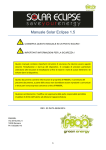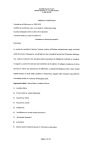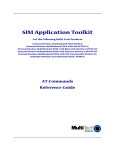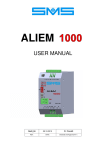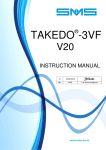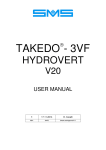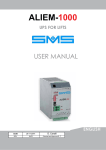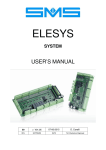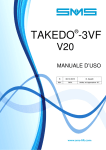Download SMS-start
Transcript
SMS-start SOFT STARTER TRIFASE 3 PHASE SOFT STARTER MANUALE D’USO USER MANUAL ITALIANO ENGLISH REV 0 PRINTED 09/2014 Printed 09/2014 SMS-start DIMENSIONI/WEIGHT A= Attacco per montaggio su DIN (DIN46277) A= Clamp for DIN rail mounting PESO: circa 1.75Kg WEIGHT: 1.75Kg approx REV 0 Printed 09/2014 SMS-start IMPORTANTE INTRODUZIONE SMS-start è un avviatore per motori asincroni trifase, adatto per ridurre la corrente di avviamento. Negli impianti di ascensore a sollevamento idraulico (tempo di avviamento 1 secondo), la corrente di avviamento si riduce a meno della metà della corrente di avviamento diretto, negli impianti tradizionali a fune (tempo di accelerazione 3 secondi) si ottiene una corrente di avviamento di circa 0,7 volte la corrente di avviamento diretto. SMS-start prevede due taglie di dispositivi, di uguali caratteristiche meccaniche ma diverse caratteristiche elettriche (vedi Cap. 3). Entrambe includono una funzione di Bypass interno per gli SCR del soft starter durante la marcia. AVVERTENZE IMPORTANTI PER LA SICUREZZA Leggere attentamente questo manuale prima di procedere all’installazione o alla manutenzione. Le avvertenze per la sicurezza non contemplano tutte le cause che provocano il malfunzionamento del dispositivo, ma danno evidenza delle cause più comuni. I simboli elencati di seguito compaiono sul presente documento o sull’apparecchiatura per avvertire di potenziali pericoli e richiedono un’attenzione speciale. QUESTO SIMBOLO INDICA DI PORRE QUESTO SIMBOLO INDICA PERICOLO PARTICOLARE ATTENZIONE DI SCARICHE ELETTRICHE Se il dispositivo è visibilmente danneggiato, se mancano componenti o se la taglia del dispositivo non è adeguata a quella del motore, NON procedere all’installazione. Quando il dispositivo è collegato alla linea è soggetto a tensioni pericolose. L’installazione, il controllo e la manutenzione del dispositivo devono essere effettuate da personale autorizzato adeguatamente istruito, e devono essere eseguite solo quando è isolato dalla rete elettrica. Un’installazione errata può causare il malfunzionamento dell’apparecchiatura, lesioni, o anche la morte. Seguire scrupolosamente le norme di sicurezza vigenti. Il dispositivo deve essere collegato a TERRA e i circuiti protetti adeguatamente, in conformità alle norme vigenti. Per garantire il corretto funzionamento del dispositivo e per non incorrere in rischi di incendio, utilizzare cavi di sezione adeguata in funzione della corrente e della lunghezza del collegamento. Evitare che qualsiasi tipo di oggetto esterno entri nel dispositivo, in quanto può portare al malfunzionamento dello stesso o a condizioni di pericolo, al momento della connessione alla rete elettrica. Assicurarsi che ai morsetti di comando del dispositivo non siano presenti tensioni con potenziali riferiti alla rete elettrica. I conduttori di controllo e di potenza devono essere accuratamente isolati gli uni dagli altri. Un eventuale gruppo di rifasamento statico deve essere connesso a monte del dispositivo (Terminali L1L2-L3) e mai a valle (Terminali U,V,W). L’errata connessione può provocare condizioni di pericolo e/o la rottura del dispositivo. Gli esempi e gli schemi contenuti in questo Manuale sono riportati a solo titolo dimostrativo. Il contenuto del presente Manuale è soggetto a modifiche senza obbligo di preavviso. In nessun caso verrà accettata la responsabilità per danni, indiretti o consequenziali, risultanti dall’utilizzo o dall’applicazione del dispositivo. REV 0 Printed 09/2014 01 ITALIANO Prima di utilizzare il prodotto, leggere il presente manuale dell’utente. Leggere con attenzione la presente sezione e attenersi con precisione alle istruzioni in essa contenute. La garanzia non copre i danni derivanti dal mancato rispetto delle istruzioni in esso contenute. SMS-start CARATTERISTICHE TECNICHE Tipo SMS-start SSV040 SSV070 Corrente nominale per carico leggero Applicazione per ASCENSORI - Servizio INTERMITTENTE (*) 40A 70A Corrente nominale per carico pesante Applicazione INDUSTRIALE -Servizio CONTINUO 30A 45A Massima corrente avviamento 120A 180A Massima corrente istantanea 180A 270A (*)Il servizio e’ da considerarsi intermittente se la motorizzazione avviene per un tempo inferiore o uguale a 60” ogni 120”. Temperatura ambiente 0 ÷ 50°C Grado di protezione IP20 NUMERO DI AVVIAMENTI/ORA SMS-start e’ progettato per poter eseguire un numero elevato di avviamenti/ora, anche in condizioni critiche. Il numero massimo di avviamenti/ora dipende dalla durata dell’accelerazione, come riportato nella tabella seguente: Tempo di accelerazione N° MAX Avviamenti/Ora 1 sec 75 avv./h 2 sec 40 avv./h 3 sec 25 avv./h 4 sec 18 avv./h 5 sec 15 avv./h La tabella riporta il massimo numero di avviamenti/ora ottenibili con 50°C ambiente e correnti di avviamento pari alla massima corrente sopportabile dal dispositivo. Con temperature inferiori e correnti minori il numero di avviamenti/ora può essere maggiore. FUSIBILI DI PROTEZIONE Al fine di proteggere la parte di potenza (SCR) ed evitare condizioni di pericolo in caso di corto circuito, si consiglia l’inserimento a monte della linea di alimentazione (L1L2-L3) di 3 fusibili con un I²t minore di quello massimo sopportato dall’SCR. I fusibili indicati nella tabella garantiscono la protezione di Tipo 2. Tipo SMS-start I²t SCR @ 45°C Tipo ITALWEBER Codice ITALWEBER I²t Fusibile SSV040 2120 CH14 50A aR 1461050 1800 SSV070 6810 CH22 80A aR 1462080 6600 COLLEGAMENTI I collegamenti elettrici al dispositivo SMS-start devono essere eseguiti rispettando gli isolamenti e le massime temperature ammesse dai cavi. La Tabella riporta le sezioni minime in caso di utilizzo di cavo tipo N07V-K. 02 SSV040 SSV070 Terminali di potenza L1-L2-L3-U-V-W 10mm² 16mm² Terminali di comando 1-2-3-4-5 1mm² 1mm² REV 0 Printed 09/2014 SMS-start COLLEGAMENTI AL MOTORE FIG. 1-COLLEGAMENTO SULLA LINEA Tipo SMS-start FIG. 2-COLLEGAMENTO NEL TRIANGOLO 6 FILI MASSIMA Corrente Motore Collegamento sulla LINEA (Fig.1) Collegamento nel TRIANGOLO (Fig.2) SSV040 40 65 SSV070 70 115 SMS-start si adatta automaticamente alla connessione eseguita ed al senso ciclico di rete. Nel caso sia necessario invertire la rotazione del motore, sarà sufficiente invertire tra di loro due fasi di alimentazione (es. R con S) e modificare opportunamente il collegamento all’eventuale dispositivo di CONTROLLO SEQUENZA FASI, per mantenerlo funzionante. IMPORTANTE! Nel caso di connessione all’interno del triangolo del motore(Fig. 2) è necessario invertire R con S e non L1 con L2! REV 0 Printed 09/2014 03 ITALIANO SMS-start può essere collegato sia sulla linea che alimenta il motore (Fig. 1), sia all’interno del triangolo del motore (Fig. 2), se si dispone di un motore con avvolgimenti collegati a triangolo quando è alimentato alla tensione di rete (es. motore 400/690 con alimentazione di rete a 400V oppure motore 230/400 con alimentazione di rete a 230V). Quando SMS-start è collegato nel triangolo, la corrente che lo attraversa (IF) è 1.6 volte inferiore rispetto alla corrente di linea (IL), per cui è utilizzabile per motori con corrente nominale 1,6 volte superiore. SMS-start COLLEGAMENTO CIRCUITI DI COMANDO FUNZIONAMENTO SMS-start e’ in grado di limitare sia la corrente di spunto assorbita dalla rete che la coppia meccanica trasferita al carico. Durante l’avviamento si ha un graduale aumento della tensione e della coppia fornita al motore, con un costante monitoraggio della corrente assorbita. A fine avviamento si ha il by-pass dei componenti di potenza, per ridurre la dissipazione e garantire un numero elevato di avviamenti/ora. La funzione di decelerazione garantisce una riduzione di coppia graduale, per un arresto “dolce”. L’avviamento del motore avviene a seguito della chiusura del contatto di marcia esterno (morsetti 1-2). SMS-start avvia il motore fornendo inizialmente la coppia di partenza impostata mediante il trimmer TORQ, e incrementandola fino alla coppia massima, nel tempo impostato mediante il trimmer ACC. All’apertura del comando di marcia inizia la decelerazione del motore, portando la tensione dal valore massimo al valore minimo, nel tempo impostato dal trimmer DEC. Durante la fase di avviamento viene monitorata la corrente di uscita. Al raggiungimento della corrente di limite impostata mediante il trimmer IMAX, si ha il ”rallentamento” della rampa di accelerazione, permettendo al motore di acquistare giri senza assorbire ulteriore corrente. 04 REV 0 Printed 09/2014 SMS-start REGOLAZIONI TRIMMER DI REGOLAZIONE ITALIANO ACC Tempo di accelerazione: Regolazione da 1 a 7 secondi. E’ il tempo in cui la tensione di uscita raggiunge il 100%, a seguito di un comando di marcia. DEC Tempo di decelerazione: Regolazione da 0 a 7 secondi. E’ il tempo in cui la tensione di uscita passa dal 100% a 0, all’apertura del comando di marcia. Se il trimmer è ruotato completamente in senso antiorario (tempo = 0), la decelerazione è disabilitata. TORQ Coppia di partenza: Regolazione da10% a 25% della coppia massima. E’ la coppia con cui il motore inizia l’accelerazione. IMAX Limite di corrente: Regolazione da 50% a 300% della corrente nominale. E’ il massimo valore di corrente che si può avere durante l’accelerazione. Al raggiungimento del valore impostato si blocca la rampa di accelerazione, allungandone il tempo. Se il tempo supera 7 secondi, il funzionamento si blocca segnalando FAULT. I TRIMMER SONO DOTATI DI PERNI PER FACILITARE LA REGOLAZIONE, SENZA USO DI ATTREZZI. AL TERMINE DELLA MESSA IN MARCIA DEL DISPOSITIVO, E’ POSSIBILE RIMUOVERLI PER EVITARE SUCCESSIVE E INOPPORTUNE MODIFICHE. SEGNALAZIONI LED DI SEGNALAZIONE PWR LAMPEGGIANTE = Alimentazione scheda Logica presente. RUN ON = Comando di MARCIA attivo. END ON = Avviamento concluso, rimane attivo durante la marcia e si spegne 0,5 secondi dopo la fine della decelerazione: chiuso il contatto 3-4 e aperto il contatto 4-5. FAULT ON= Stato di Blocco o di Fault generico. Per ripristinare il funzionamento, occorre togliere il comando di marcia. PROTEZIONI • • • • • • Controllo della presenza delle fasi d’ingresso prima di effettuare l’avviamento. Controllo della presenza del motore prima di effettuare l’avviamento. Controllo termico sui componenti di potenza. Controllo sul corretto funzionamento dei relè di bypass. Controllo sul corretto funzionamento degli SCR. Controllo di corrente massima durante l’avviamento. REV 0 Printed 09/2014 05 SMS-start RISOLUZIONE PROBLEMI FORMATO CODICE SMS-start 06 REV 0 Printed 09/2014 SMS-start NOTICE INTRODUCTION SMS-start is a three-phase asynchronous motor starter, designed to reduce starting current. In hydraulic lift systems (1-second starting time), the starting current is reduced to less than half of the direct starting current. In traditional rope lift systems (3-second acceleration time), a starting current of approximately 0.7 times the direct starting current can be obtained. SMS-start has two sizes with the same mechanical outfit but different electrical properties (see Chapter 3). Both include an internal Bypass function for the soft starter SCRs during runtime. IMPORTANT SAFETY WARNINGS ANT Please read this manual carefully before proceeding with installation or maintenance. The safety warnings do not cover all causes of device failure, but do identify the most common causes. The following symbols appear in this document or on the equipment to warn of potential hazards, and they require special attention. YOU MUST PAY PARTICULAR RISK OF ELECTRIC SHOCK ATTENTION If the device is visibly damaged or missing components, or if the size of the device is not suitable for the motor, DO NOT proceed with installation. When the device is connected to the mains it is subject to hazardous voltages. Installation, inspection and maintenance of the device must be performed by authorised and appropriately trained personnel, and should be performed only when it is disconnected from the electric network. Incorrect installation can cause equipment malfunction, injury or even death. Carefully follow the safety regulations in force. The device must be connected to GROUND and the circuits adequately protected, in accordance with current standards. To ensure correct device operation and in order to avoid the risk of fire, use cables with a suitable cross section, depending on the current and the length of the connection. Ensure that no type of external object enters the device, as it can lead to failure of the product or hazardous conditions, when connecting to the electric network. Make sure that there is no voltage on the device control terminals which could link to the electric network. The control and power conductors must be correctly isolated from each other. Any static power factor correction unit must be connected upstream of the device (Terminals L1L2-L3) and never downstream (Terminals U, V, W). Incorrect connection may cause hazardous conditions and/or device breakage. The examples and diagrams in this manual are included solely for demonstration purposes. The content of this manual is subject to change without notice. In no event shall liability be accepted for damage, indirect or consequential, resulting from the use or application of the device. REV 0 Printed 09/2014 07 ENGLISH Please read the manual before using and installing the device. Read carefully the following paragraphs and pay attention to the instructions. Our warranty does not cover any damage resulting from failure to follow instructions contained therein. SMS-start TECNICAL FEATURES Type of SMS-start SSV040 SSV070 Rated current for light load Application for LIFTS - INTERMITTENT duty (*) 40A 70A Rated current for heavy load INDUSTRIAL application - CONTINUOUS duty 30A 45A Maximum starting current 120A 180A Maximum instantaneous current 180A 270A (*)Duty is considered intermittent where the motor drive starts for a duration below or equal to 60” each 120”.Ambient temperature 0 ÷ 50°C . Degree of protection IP20 NUMBER OF STARTS/HOUR SMS-start is designed to be able to carry out an increased number of starts per hour, even in critical conditions.The maximum number of starts per hour depends on the acceleration duration, as shown in the Table below: Acceleration time MAX No. Starts/Hour 1 sec 75 starts/h 2 sec 40 starts/h 3 sec 25 starts/h 4 sec 18 starts/h 5 sec 15 starts/h The Table shows the maximum number of starts per hour which can be obtained at an ambient temperature of 50°C and at starting currents equal to the maximum current supported by the device. PROTECTION FUSES In order to protect the power component (SCR) and to avoid dangerous conditions in the event of a short circuit, you are advised to install, upstream of the power line (L1-L2-L3), 3 fuses with an I²t the the one is supported by the SCR. The fuses shown in the Table ensure Type 2 protection. Type of SMSstart I²t SCR @ 45°C Type ITALWEBER Code ITALWEBER I²t Fuse SSV040 2120 CH14 50A aR 1461050 1800 SSV070 6810 CH22 80A aR 1462080 6600 CONNECTIONS The electrical connections to the SMS-start device must be carried out in accordance with the isolations and maximum temperatures allowed by the cables. The Table shows the minimum cross sections, where N07V-K type cables are used. SSV040 SSV070 Power terminals L1-L2-L3-U-V-W 10mm² 16mm² Command terminals 1-2-3-4-5 1mm² 1mm² 08 REV 0 Printed 09/2014 SMS-start CONNECTIONS MOTOR PICTURE. 1-CONNECTION ON LINE TYPESMS-start PICTURE. 2-INSIDE CONNECTION IN DELTA MAX Motor Current Connection on line (Picture 1) Connection on delta (Picture 2) SSV040 40 65 SSV070 70 115 SMS-start adapts automatically to the connection implemented and to the network phase sequence. In the event that it is necessary to reverse the motor rotation, it is sufficient to reverse two supply phases between them (e.g. R with S), and consequently modify the connection of the eventual PHASE CONTROL device, so that it keeps working fine. IMPORTANT! In the case of internal delta connection, it is necessary to reverse R with S and not 1 with L2! REV 0 Printed 09/2014 09 ENGLISH SMS-start can be connected either on the line that powers the motor (Fig. 1), or inside the delta of the motor (Fig. 2), if you are using a motor with the windings connected in delta when powered by mains voltage (i.e. 400/690 motor with 400V mains power or 230/400 motor with 230V mains power). When SMS-start is connected to the delta, the current passing through it (IF) is 1.6 times lower than the line current (IL). It can therefore be used for motors with a rated current 1.6 times greater rated current. SMS-start CONTROL CIRCUITS CONNECTION OPERATION SMS-start is able of limiting both the inrush current absorbed from the network, and the mechanical torque transferred to the load. During start-up, there is a gradual increase in voltage and torque supplied to the motor, with constant monitoring of current consumption. At the end of start-up, there is a power components bypass. This reduces power dissipation and ensure a high number of starts per hour. The deceleration function ensures a gradual reduction in torque, for a “soft” stop. Starting of the motor takes place following closure of the external run contact (terminals 1-2). SMS-start starts the motor by initially providing the starting torque set by the TORQ trimmer, and increasing it up to the maximum torque, in the time set by the ACC trimmer. Motor deceleration begins on opening of the run command, moving the voltage from the maximum value to the minimum value, within the time set by the DEC trimmer. During the starting phase the output current is monitored. On reaching the current limit set by the IMAX trimmer, the “slowdown” of the acceleration ramp takes place, allowing the motor to rev without using additional power. 10 REV 0 Printed 09/2014 SMS-start ADJUSTMENT ENGLISH ADJUST TRIMMER ACC Acceleration time:Adjustment from 1 to 7 seconds. This is the time during which the output voltage reaches 100%, following a run command. DEC Deceleration time: Adjustment from 0 to 7 seconds. . This is the time during which the output voltage passes from 100% to 0, on opening of the run command. If the trimmer is turned fully clockwise (time = 0), deceleration is disabled. TORQ Starting torque: Adjustment from 10% to 25% of maximum torque. This is the torque with which the motor will begin acceleration. IMAX Current limit: Adjustment from 50% to 300% of rated current.This is the maximum current value admit during acceleration.When the set value is reached, the acceleration ramp locks, thereby increasing its duration. If the time exceeds 7 seconds, operation locks and FAULT is indicated. THE TRIMMERS ARE EQUIPPED WITH PINS IN ORDER TO FACILITATE ADJUSTMENT, WITHOUT THE USE OF TOOLS. AT THE END OF THE START-UP OF THE DEVICE, YOU CAN REMOVE THEM TO AVOID LATER INAPPROPIATE CHANGES. INDICATORS LED INDICATORS PWR FLASHING = Logic board power supply present. RUN ON= RUN command active. END ON= Start complete, remains active during the run and goes off 0.5 seconds after deceleration is complete: contact 3-4 closed and contact 4-5 open. FAULT ON= Generic Lock or Fault state. To restore operation, you must stop the run command. SAFEGUARDS • • • • • • Checking for the presence of input phases before carrying out start-up. Checking for the presence of the motor before carrying out start-up. Heat checking of the power components. Checking of correct operation of the bypass relays. Checking of correct operation of the SCRs. Checking the maximum current during start-up. REV 0 Printed 09/2014 11 SMS-start TROUBLESHOOTING SMS-start CODE FORMAT 12 REV 0 Printed 09/2014 REV 0 Printed 09/2014 13 SMS Sistemi e Microsistemi Srl (SASSI HOLDING Group) Via Guido Rossa, 46/48/50 Loc. Crespellano, 40053 Valsamoggia (Bologna), Italy Tel. +39 051/969 037 Fax +39 051/969 303 [email protected] www.sms-lift.com
















